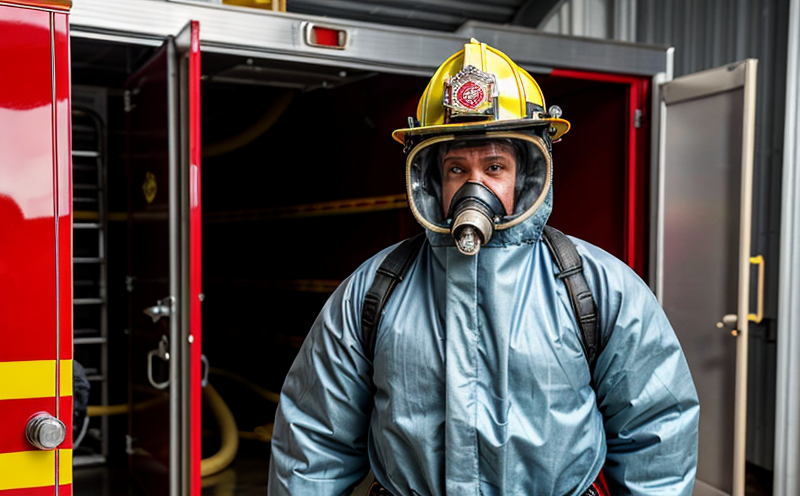Mechanical Stress Testing of Protective Clothing
Firefighter protective clothing plays a critical role in safeguarding firefighters from the extreme conditions they encounter while performing their duties. The mechanical stress testing of this protective gear is essential to ensure that it meets stringent safety standards and provides reliable performance under various stress scenarios. This service involves subjecting samples of firefighter protective clothing to controlled mechanical stresses, simulating real-world conditions to assess their durability, tensile strength, tear resistance, puncture resistance, and other critical properties.
The testing process begins with the selection of appropriate test specimens that accurately represent the areas of highest stress during firefighting activities. These specimens are cut from various parts of the protective clothing such as the torso, sleeves, and lower body segments to ensure comprehensive evaluation. The mechanical stress testing apparatus is designed specifically for this purpose, incorporating fixtures capable of simulating a range of stress conditions.
The first step in the testing process involves preparing the specimen according to the relevant standards (e.g., ISO 17492:2008 for protective clothing). This includes ensuring that any necessary pre-treatments are applied and that the environment is controlled to avoid external factors influencing test results. Once prepared, the specimens undergo a series of mechanical stress tests using specialized equipment.
Common types of mechanical stress tests include:
- Tensile strength testing: This evaluates the maximum force the fabric can withstand before it starts to elongate or tear.
- Puncture resistance testing: This measures how much pressure is required to puncture the material, simulating sharp object impacts that firefighters may encounter.
- Bending and flexing tests: These assess the ability of the clothing to bend and flex without compromising its structural integrity.
The results of these tests are meticulously recorded and compared against specified acceptance criteria. For instance, according to ISO standards, protective clothing must meet certain minimum tensile strengths and puncture resistance values to be considered safe for use by firefighters. Compliance with these criteria is crucial as it ensures that the protective clothing can withstand the physical demands placed upon it during firefighting operations.
The mechanical stress testing of protective clothing is not just about meeting regulatory requirements; it also contributes significantly to firefighter safety and well-being. By identifying potential weaknesses in the design or manufacturing process, this service helps manufacturers improve the performance and reliability of their products. This, in turn, enhances the overall effectiveness of firefighters when they are called upon to respond to emergencies.
Moreover, the mechanical stress testing of protective clothing is a key component of quality assurance programs within fire departments. Regular testing ensures that all issued gear continues to meet stringent safety standards over its lifespan. This proactive approach helps prevent incidents where compromised protective equipment could put firefighters at risk. In addition, it fosters continuous improvement in materials science and design, leading to the development of next-generation protective clothing that offers enhanced protection.
Firefighters rely on their protective gear as a critical line of defense against hazardous conditions. Ensuring this gear meets rigorous mechanical stress testing standards is fundamental to maintaining firefighter safety and effectiveness. Through comprehensive testing procedures, we help safeguard our firefighters by providing them with the most reliable and robust protective clothing available.
Benefits
The benefits of mechanical stress testing in fire protection extend beyond mere compliance with regulatory requirements. This service provides numerous advantages that contribute to firefighter safety and operational effectiveness:
- Enhanced durability: By identifying weaknesses early, manufacturers can improve the design and materials used in protective clothing.
- Increased reliability: Consistent performance across all test specimens ensures uniform quality of protective gear issued to firefighters.
- Potential cost savings: Identifying issues during testing helps avoid costly recalls or replacements after deployment.
- Improved reputation: Demonstrating adherence to high-quality standards can enhance the public perception and trust in fire services.
The mechanical stress testing of protective clothing is an integral part of a comprehensive quality assurance program. By incorporating this service into their regular maintenance protocols, fire departments can ensure that their personnel are equipped with the best possible protection. This not only enhances operational efficiency but also contributes to a safer working environment for all firefighters.
Customer Impact and Satisfaction
The mechanical stress testing of protective clothing has a direct impact on customer satisfaction within fire departments. When this service is implemented effectively, it leads to several positive outcomes:
- Increased confidence in equipment: Firefighters who know their gear meets rigorous standards are more confident and secure when performing their duties.
- Reduced downtime: Equipment that passes mechanical stress testing is less likely to fail during critical incidents, minimizing disruptions and ensuring continuous service availability.
- Better resource allocation: By focusing on high-performing protective clothing, departments can allocate resources more efficiently, potentially freeing up personnel for other tasks.
A satisfied customer in this context means a fire department that operates with greater efficiency and effectiveness. The mechanical stress testing service helps achieve this by providing robust, reliable protective gear to firefighters. This, in turn, contributes to higher morale among the workforce and improved community safety outcomes.
Environmental and Sustainability Contributions
The mechanical stress testing of protective clothing also has significant environmental and sustainability contributions:
- Reduced waste: By ensuring that protective clothing meets stringent standards, the likelihood of premature disposal is reduced.
- Eco-friendly materials: The service encourages the use of sustainable materials in manufacturing, which can have a positive impact on the environment.
- Energy efficiency: Improved durability and reliability mean that protective gear lasts longer, reducing the frequency of replacement and associated resource consumption.
Through these contributions, the mechanical stress testing service plays a vital role in promoting sustainability within fire departments. By adhering to rigorous testing protocols, we help ensure that firefighters have access to high-quality, durable equipment while minimizing environmental impact.





